 Port Credit Marine Surveys & Yacht Delivery Society of Accredited Marine Surveyors  Your delivery crew 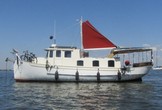 Our own boat  My first boat  My previous boat 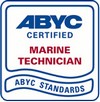 American Boat & Yacht Council  BoatUS® 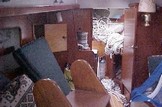  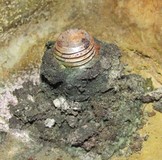 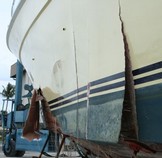  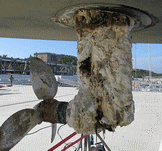 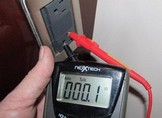 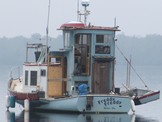
|
BALSA CORE = COMPOST You may think this title a little harsh but given the amount of rotten balsa I see through my surveys I think it is warranted. Many fine boats have been built with balsa core and many 30 year old balsa cored hulls are still sound today but many are not and it sometimes takes a very experienced eye to tell the difference.This article was prompted by the experience of a friend in Toronto who bought a 2002 model boat, titled and launched in the spring of 2004 and after spending only 16 weeks in water developed a crack at one of two throughulls over the winter storage period. He asked me to take a look. I found about 3'sq' around one throughull with very high moisture levels and dull percussive soundings. I told him to pull the throughull fitting as it was not unusual for the builders to forget to seal the core after drilling a hole for the fittings......guess what......he removed the fittings and found saturated balsa core . It is very likely that the crack at this throughull was caused by the water expanding as it froze over the winter. After I left he pulled another throughull and found the same condition To see high moisture levels in the core in a modern vessel which has spent only 16 weeks in water is in my opinion inexcusable and certainly does not suggest a long healthy life for this boat. The exposed core at both throughulls and the crack at one of them will certainly shorten the life of the core in my friends boat ! In the late 90's to early 2000's Sea Ray had a number of well publicized issues with balsa core saturation in some of their hull models. They had not sealed the core where they cut through the hull to install the air intake/output plenums in the topsides leading to extensive balsa decay an a number of lawsuits. The manufacturer of the core was brought into the picture to defend Sea Ray with a number of magazine articles and seminars for surveyors. I attended one of these seminars and their story was that even high moisture levels in balsa did not significantly reduce the strength (tests proved this part true, to a point) and that balsa cannot decay unless exposed to oxygen and bacteria. They forgot a couple of things, first if water is getting into the core, by definition so is oxygen. Second they didn't even know that anaerobic enzymes existed and will feast on the balsa without oxygen. What does this have to do with moisture meters ?.... If the FRP skin has disbonded from the saturated core, the meter will not pick up the high moisture as there is no continuity between the materials. If the core has completely degraded to a state of near dust (more common than you'd think) there is little moisture to measure so the meter shows low numbers.US MIL-specs call for balsa core to be kiln dried to not more than 15% nor less than 5% moisture with an average of not more than 12% in any one batch and to be maintained in that condition up to the point of construction so your balsa had moisture in it right from day one. There are two principal reasons for this MIL-spec, a). Fungal or bacterial growth is unlikely below 15% moisture content and b). Adhesion of resins whether polyester, vinylester or epoxy is greatly reduced as moisture content in the core is increased above this level. So if the factory and storage conditions are up to MIL-spec standards, the balsa in your deck should have started out with not more 15% moisture by weight. How many pleasurecraft builders have the environmental controls in their warehouses to achieve this ?. I witnessed many Canadian builders over the years store skids of balsa in the parking lot and never saw one with an environmentally controlled production facility. Chances are fair that your balsa core had too much moisture in it from the day the hull was molded.. The major advantage I have with meters is that over the years I have seen hundreds of structures opened up after I had taken readings. This has allowed me to see exactly what the meter was saying and it was not always what it appeared. In fact I saw so many high readings that had nothing to do with moisture and quite a few saturated cores that showed low moisture that I am now a little skeptical. I do use a meter but try to check high readings by other methods as well. |
|
| If you read my other article on "Moisture Meter Myths" then you know that I do not fully
trust these meters however, as this boat
has never had any antifouling paint to confuse
the meter, the bottom was clean gelcoat and
the vessel had been out of the water all
winter, I feel quite comfortable with the
readings I found. Most of the hull checked
sound with moisture levels reading 11-13
while the areas around the head intake throughull
checked dull and read 29-30. I do not find
this acceptable in a modern vessel after
only 16 weeks in water and five months dry
storage. It should also be noted that high
moisture levels were also found around the
I/O transom assembly cutout, another area
of exposed wood the builders frequently forget
to seal. Unfortunately I have found that
many boat surveyors know little about moisture
meters so the best defense is to read my
Moisture meter article and perhaps my Osmosis Mythology article too so you will know if your marine
surveyor knows what he is talking about. The Manufacturers Point of View The manufacturers of balsa and balsa cored hulls tell us that wet balsa in a hull does not compromise its structural integrity. They claim that moisture spreads very slowly if at all horizontally due to the end grain cut of the balsa core. They are also state that balsa will not rot (even with high moisture content) unless it is exposed to oxygen and go on to claim that if properly installed, no oxygen will get to it, therefore it cannot rot. They state that water permeating through FRP does so at a molecular level therefore with so little oxygen it cannot support fungal growth. They also say that frozen, saturated core cannot fracture FRP or cause the core to separate from the FRP. One manufacturer states " There are standards for balsa core when used in production. There are no standards in regard to core once it is encapsulated in a laminate". The Flip side Their arguments are heavily qualified by "if " . If the core is properly fitted and properly sealed (inside and out) and if there are no penetrations by fasteners, throughulls or fittings. they may be right. Unfortunately few boats are built the way core makers would like. First….. If water is getting into the core so is oxygen, that's why it's called H2O. It gets there not only by permeation at a molecular level but through improperly fitted throughulls, Trim tab mounting screws, transom mounted transducers, screws through the inner FRP in the bilges from the many items fastened to the inner hull and often right through resin starved, poorly applied chopped FRP on the hull interior. Second..…. Even though the water will contain oxygen, wood will rot without it due to the presence of anaerobic bacteria. Much like a compost heap, the real decay occurs deep in the pile where aerobic (oxygen requiring bacteria) cannot survive but where an anaerobic bacterium thrives. Do a google on "anaerobic, balsa, decay" just for fun. Third….. Water will travel much more slowly horizontally through the balsa if the ends are near perfectly encapsulated and all the kerfs in the balsa are filled with resin. I have never seen a core sample in which all the kerfs were filled and the core /laminate joint was void free. I doubt you will find any surveyor who has. Fourth..…. While saturated core may not pose an immediate threat to the vessel it will definitely lead in that direction as the extra 800lbs. cannot do it much good. As a basic rule of physics we all know that water is not compressible and when the water filled xylem (capillaries in the balsa) are slammed into a 2-3' wave at 20knots the entrapped water will burst through the xylem walls thus hastening a horizontal movement of the water and weakening the core. David Pascoe (www.yachtsurvey.com) has termed this process "hydraulic erosion", an apt description I think. Don't forget that the xylem walls may have already been weakened by the anaerobic bacteria feeding on the lignin which is the glue that holds the xylem together. |
||
| Fifth.....They claim that a saturated, frozen area
of core will expand into unsaturated area
and not up (or down) to the FRP skin. Take
a look at the photo number 4 which shows
the side rail of a stainless steel tube ladder
that had about one foot of water in the lower
part of its 6' length. If they were right,
the water should have expanded up the tube
instead of bursting through the side. I don't believe you can keep water out of a balsa core indefinitely but I have seen many 30 -40 year old sailboats with balsa cored hulls which still show only very slightly elevated moisture content (and more than a few that were completely rotten). Lets take a look at my own boat ............ (These are not "bottom" examples but are the best shots I have) Photo number 1 shows the inside surface of the bulwarks around my decks where I cut out the inner skin to expose the "compost". Keep in mind that these bulwarks are about 18" above the water line and that there are no holes of any kind for fasteners, through hulls or anything else. So why did I have to dig out about 30lbs. of compost ? YES ! that is exactly what it looks like and it is a miserable job. So if this can happen 18" above the waterline. Imagine what can happen to balsa below the water line if everything is not installed to PERFECTION ! Then ask yourself when you have seen anything done on a production boat to perfection. Photos number 2 and 3 show the cored area on my transom above the stern lockers, about 3' above the waterline and again with no holes for fasteners or throughulls and once again with more balsa "compost. Now if this can happen 3' above the water line, how on earth can the manufacturers claim in good conscience that it does not happen below. What does this mean to a surveyor ? On decks, wet or rotted core is usually easy to detect because the FRP skin is generally thinner than the hull and therefore more easily sounded and moisture meters are more reliable because they are not confused by multiple layers of who knows what kind of bottom paint. Wet or rotted core can be more difficult to detect on bottoms or stringers as the FRP skin may be too thick for the meter to read through and metallic compounds in multiple layers of different bottom paints may also confuse the meter. If the core has rotted and is not in contact with the skin again the meter may not pick up the moisture. If the vessel being surveyed is blocked or on a trailer, the pressure of the support points may mask an area of core separation or rot. Percussive soundings may be less reliable for the same reasons. A surveyor must be cautious about moisture statements and core condition because sometimes the only way to be sure is to cut a hole and look ! What does this mean to the boat owner..... A saturated core will eventually separate from the FRP skin and I still believe this can be hastened by our freeze thaw cycle here in the Great White North. If our winters can fracture cast iron water pipes and heave our roadways, what do you think it does to the microscopically thin cellulose of the balsa. The skin can crack and allow in yet more water. At 10lbs. per imperial gallon of water, how much of this stuff do you want to carry around in your core. Pounding a 7000lb boat at 18 knots through a 2-3' chop will certainly put a strain on your saturated core. How easy will it be to sell a wet core boat with cracks all over the bottom ? Quick, put on another couple of coats of bottom paint, maybe the buyer won't notice ! So, can a quality boat be built with a balsa bottom ? Yes they can and are but it requires great care and attention to details like relieving all balsa in areas with deck fittings, throughulls or even just screws as well as a good layup, quality resins, ensuring that resin fills all kerfs in the core and a vinlyester gelcoat. The chances of all this being done well on a production boat are slim. Boats are built with balsa because it can be cheaper (maybe not if you do it right) and lighter than achieving the same initial strength with solid FRP. Are you willing to bet that your builder wants to build cheap but then pays the extra attention required to do it right ? I sometimes wonder if builders can do much right. Don't believe me ... Take a look at "Stoopid Boat Tricks By Builders". |
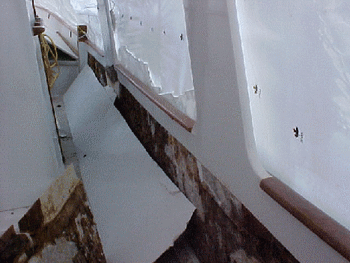 1. 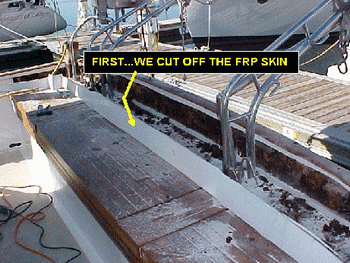 2. 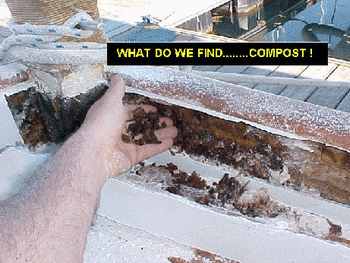 3. 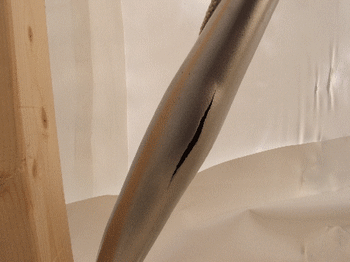 4. |
|
 |
William Wallace Gouk AMS®, Society of Accredited Marine Surveyors®, Accredited Marine Surveyor, Seal No. 757 Transport Canada Licensed Master, Transport Canada Tonnage Measurer, ABYC® Certified #10952, BoatUS® Approved Marine Surveyor A Marine Surveyor for Ontario from Mississauga, Toronto, Hamilton to Oshawa, Whitby, Newcastle, Pickering, Trenton, Kingston, Gananoque and beyond |
|